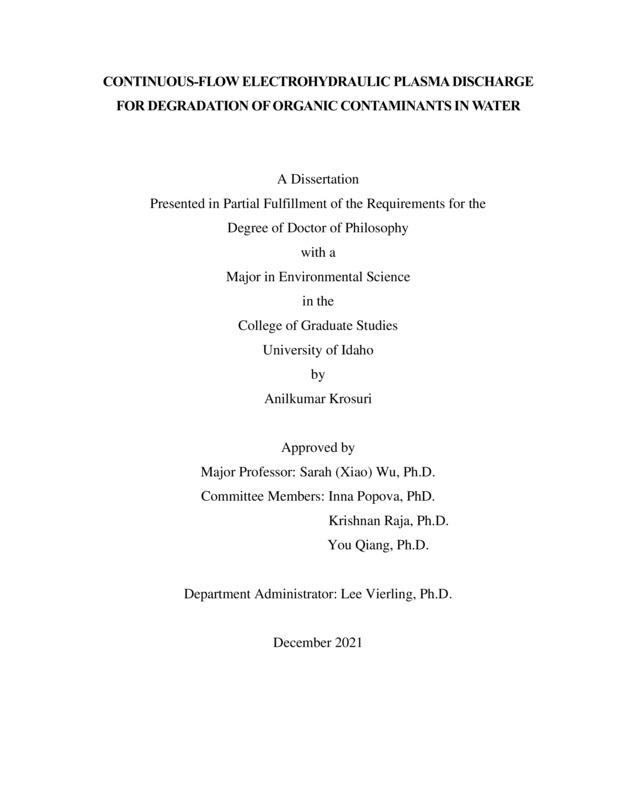CONTINUOUS-FLOW ELECTROHYDRAULIC PLASMA DISCHARGE FOR DEGRADATION OF ORGANIC CONTAMINANTS IN WATER
Krosuri, Anilkumar. (2021-12). CONTINUOUS-FLOW ELECTROHYDRAULIC PLASMA DISCHARGE FOR DEGRADATION OF ORGANIC CONTAMINANTS IN WATER. Theses and Dissertations Collection, University of Idaho Library Digital Collections. https://www.lib.uidaho.edu/digital/etd/items/krosuri_idaho_0089e_12285.html
- Title:
- CONTINUOUS-FLOW ELECTROHYDRAULIC PLASMA DISCHARGE FOR DEGRADATION OF ORGANIC CONTAMINANTS IN WATER
- Author:
- Krosuri, Anilkumar
- Date:
- 2021-12
- Embargo Remove Date:
- 2023-12-21
- Program:
- Environmental Science
- Subject Category:
- Environmental engineering; Nanotechnology; Plasma physics
- Abstract:
-
The water quality has been deteriorated with the introduction of aromatic organic compounds such as azo dyes and phenolic pollutants due to the poor water management by industries. These pollutants end up into potable water supplies and can pose serious threat to human health even at low concentrations, as conventional wastewater treatment technologies are often incapable of eliminating them from treated water. Therefore, the development of novel and greener oxidation technologies has become a main challenge to degrade a variety of hazardous organic pollutants in wastewater. In this research, a continuous-flow electrohydraulic plasma discharge (EHPD) process and a photocatalyst was developed and evaluated for its potential to treat organic pollutants such as methylene blue (MB) and p-Nitrophenol (p-NP). In Chapter 2, visible-light driven bismuth oxyiodide modification by carbon-boron nitride quantum dots (BiOI/C-BNQDs) was prepared and characterized as a photocatalyst for degradation and mineralization of p-Nitrophenol. C-BNQDs was synthesized using a microwave process and crosslinked with BiOI using a facile method. The structure, functional bonds, composition and morphology of the catalyst were investigated through series of characterization such as XRD, FTIR, XPS, SEM and TEM, and it was found that the photocatalytic activity of the BiOI/C-BNQDs against the p-NP degradation achieved the highest reaction rate of 0.0173 min−1, which was 2.83 higher than the reaction rate constant of BiOI. From the active species trapping experiment, the reactive •O2 − plays the major role followed by holes and hydroxyl radicals in the p-NP degradation. The probable photo degradation mechanism was discussed. In Chapter 3, the continuous-flow electrohydraulic plasma discharge (EHPD) process characteristic of establishing a stable discharge through the conducting channel in the center orifice of a dielectric plate was developed and investigated to degrade methylene blue (MB) in water. The effect of three operating parameters, i.e., liquid flow rate (37−94 mL/min), air flow rate (1−4 L/min), and initial dye concentration (10−100 mg/L), on the MB degradation efficiency was evaluated. Complete degradation of MB was achieved within 10 min of treatment for all MB concentrations tested. The optimum liquid and air flow rates were 68 mL/min and 3 L/min, respectively, for the EHPD process to remove MB in a circular flow operation. The energy yield for different operating parameters was in the range of between 0.16 g/kWh and 0.81 g/kWh at 50% conversion. Reaction kinetics and the possible MB degradation pathway was analyzed and proposed. Hydroxyl radicals were found to be the dominant reactive species responsible for the MB degradation. Mineralization of MB was demonstrated by a 92.5% COD removal within10 min treatment for an initial MB concentration of 100 mg/L. Chapter 4 initiated the optimization and modeling of argon activated EHPD process for efficient removal of p-NP from water. First, the reactor was designed with two dielectric plates to initiate better plasma discharge through the conducting channel in the center orifice. Second, the effects of four operating variables including argon flow rate, pH, applied power and persulfate dosage on the p-NP degradation efficiency and energy yield were investigated to screen the significant factors using a fractional factorial design (FFD). Argon flow rate and applied power were found as significant factors, which were further optimized with response surface methodology (RSM) and the optimal operating condition was found to be 2.73 L/min and 128.6 W for argon flow rate and applied power, respectively. Under the optimal condition, 10-min treatment of 50 mg/L p-NP showed a degradation efficiency of 94.23%, first-order reaction rate constant of 0.2956 min-1 and an energy efficiency of 0.22 g/kWh. OES, TOC, radical scavengers, ion chromatography and UPLC-MS/MS were used to investigate and propose the reaction mechanism and pathway for degradation of p-NP on exposure of EHPD. Coupling the BiOI/C-BNQDs catalyst prepared in Chapter 2 with EHPD process for effective and efficient degradation and mineralization of p-NP was studied in Chapter 5. Under the optimum operating condition determined in Chapter 4, the addition of BiOI/C-BNQDs (3 mL) in EHPD process improved the system in terms of degradation, H2O2 concentration, TOC removal and energy yield within 10 min of treatment for 50 mg/L p-NP concentration, as compared to the sole EHPD process. The OES spectra identified •OH, •O, and H as the reactive species involved in the EHPD/BiCBN-3 treatment and radical scavenging experiment confirmed •OH radicals as the main active species for p-NP degradation. Finally, the synergistic mechanism and degradation pathway of p-NP by EHPD/BiCBN-3 system was proposed. In summary, the novel continuous-flow EHPD process developed in this research is robust, highly effective, and energy efficient for degradation and mineralization of MB and p-NP and serves a potential technology that can overcome the limitations of advanced oxidation processes for wastewater treatment. The EHPD or EHPD-catalyst system could also be a promising remediation methodology for emerging contaminants that are recalcitrant to biodegradation and existing advanced oxidation processes.
- Description:
- doctoral, Ph.D., Environmental Science -- University of Idaho - College of Graduate Studies, 2021-12
- Major Professor:
- Wu, Sarah (Xiao)
- Committee:
- Popova, Inna; Raja, Krishnan; Qiang, You; Vierling, Lee
- Defense Date:
- 2021-12
- Identifier:
- Krosuri_idaho_0089E_12285
- Type:
- Text
- Format Original:
- Format:
- application/pdf
- Rights:
- In Copyright - Educational Use Permitted. For more information, please contact University of Idaho Library Special Collections and Archives Department at libspec@uidaho.edu.
- Standardized Rights:
- http://rightsstatements.org/vocab/InC-EDU/1.0/

